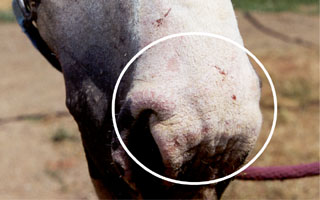
|
|
toxic metals | poisoning that causes sudden death | plants causing skin, hair, and hoof problems | plants affecting the nervous system | plants causing bloody or dark urine | plants that affect the mouth | plants causing congenital defects and abortion
Introduction:
The list of possible toxic plants and substances for animals is very long. These toxic plants and substances can be a source of decreased growth, increased disease, and even death in horses. Many times, solving a case of intoxication includes taking samples of the feed from hay or pasture. Samples may also need to be taken from an animal during a necropsy and evaluated for different toxic components. When a necropsy is performed, the liver, brain, kidney, stomach contents, and eye fluid (vitreous) are some of the most important tissues or areas to sample.The key to solving any suspected case of intoxication is to take the proper samples and handle these samples correctly. Because collection and handling are so important, the following are a few suggestions:
The following information will be broken down into toxic substances and toxic plants. The toxic plant section will then be broken down into plants that cause sudden death, skin/hair/hoof problems, nervous system problems, bloody or dark urine, mouth problems, and congenital defects or abortions. Some of the following plants may not be routinely consumed by horses, and therefore, are not commonly considered a problem.
Toxic Substances:
Toxic Plants
- Two key principles to understand:Animals rarely eat toxic plants when there is plenty of normal forage available.
Plant poisoning that causes sudden death:
- Poison hemlock, European hemlock, spotted hemlock,
California fern (Conium maculatum)
Plant Description: This plant is 4-6 feet tall, with branching, hollow stems. The stems have purple spots, especially near the base, and fern-like leaves growing on alternate sides of the stem. The root resembles a carrot and is highly toxic. The flowers are composed of tiny, upright stems clumped together with a small, white, 5-petaled flower on each stem. Together, they form a broad flat-topped cluster. This plant has an overall pungent odor. The most toxic parts of the plant are the leaves and stems prior to seed development; the seeds are highly toxic once they are formed.
Clinical Signs: Signs develop within 1 hour of ingestion of the lethal dose, which can be as little as Ĺ of 1% of the animalís body weight. These signs include salivation, muscle tremors, clumsiness, difficulty breathing, weak pulse, frequent urination and defecation, temporary blindness, a bluish color (cyanosis) of the mucous membranes, and a coma. Death normally occurs within 2-3 hours of the onset of clinical signs. Pregnant animals that ingest poison hemlock can have abortions.
Treatment: Currently, there is no treatment available for hemlock poisoning.
Prevention: Mowing or spraying of hemlock stands before the seed stage can reduce poison hemlock problems.
- Yew (Taxus spp.)
Plant Description: The yew is commonly used for landscaping purposes as an ornamental shrub or small tree. Yew is an evergreen plant with glossy dark green leaves that resemble a short, flattened pine needle. This shrub bears a yellow or red fruit with a single seed or "pit" in the center, and is very similar in appearance to an olive. The fleshy red or yellow part of the fruit surrounding the pit is the only part of this plant which is not toxic. All other parts of the plant are toxic, whether they are dry or fresh, and as little as 8-16 oz. of yew leaves can be fatal to adult animals. Generally, if horses have adequate nutrition, and are not hungry, they will not eat yew.
Clinical Signs: Signs of yew poisoning include muscle trembling, clumsiness, nervousness, difficulty breathing, slow heart rate, diarrhea, convulsions, then death. Horses are the most severely affected animal species.
Treatment: Currently, there is no treatment available for yew poisoning.
Prevention: Never plant a yew hedge or border around animal enclosures, and do not feed horses clippings from yew plants.
These plants release cyanide when they are damaged or exposed to drought and frost conditions. Following is a list which shows the plants that are most often associated with animal poisoning. Some of the following plants are grown as food for both animals and humans, while others are grown for fiber and oils. If careful attention is paid to the growth stage of the plant and the growing conditions, these plants can safely be used. Cool, moist growing conditions and nitrate fertilizer are known to elevate levels of cyanogenic poison in the plants. All parts of the following plants are toxic, unless otherwise noted.Introduction:
Animals with stomach contents that are more acidic are less likely to suffer fatal cyanide poisoning. Simple stomached animals (humans, horses, pigs, etc.), fit this criteria. Because horses are simple stomached animals, they rarely suffer from cyanide poisoning.
The lethal dose of cyanide is 1 mg/lb for most animal species. If the stomach is full of plant matter and carbohydrates, the animal may tolerate a higher dose of cyanide. Along with consuming one large dose of cyanogenic plants, consuming small amounts of cyanide consistently over a long period of time, can also prove fatal.
Clinical Signs: Early signs include rapid, labored breathing, frothing at the mouth, dilated pupils, muscle incoordination (ataxia), muscle tremors, and convulsions. The venous blood is cherry-red in color because it is unable to release oxygen to the tissues. Mucous membranes become a bright cherry-red in color once the animal has been poisoned, and fade to a bluish color when the animal is close to death. An increased heart rate and recumbency (lying down unable to rise) are other terminal signs of cyanide poisoning. In an acute case, sudden death is usually the only sign. Animals rarely survive more than 1-2 hours after ingesting a fatal dose of these plants, and are often dead within minutes of showing clinical signs.
Diagnosis: Cyanide poisoning is usually diagnosed at necropsy. In order for the necropsy results to be accurate, tissue samples must be collected within a few hours of death and frozen immediately. Liver, muscle, and stomach contents must be frozen in air-tight containers and sent to a laboratory for analysis and diagnosis. If an animal has been diagnosed with cyanide poisoning, there are commercial test kits available to test plants for cyanide content (Toxitest). Stomach contents can also be tested for cyanide with similar tests.
Treatment: Treatment involves accelerating the rate the body metabolizes the poison, thereby inactivating it. This is usually accomplished in animals by administering an IV dose of a mixture of 1 mL of 20% sodium nitrite, plus 3 mL of 20% sodium thiosulfate (for total of 4 mL). For every 100 lbs. of body weight, administer 4 mL of this solution. The dose may be repeated in a few minutes if the animal does not respond. Use caution when administering additional doses of this solution, because additional nitrite can also cause poisoning. After administering the above mixture, 30 gm of sodium thiosulfate can be given orally to detoxify any cyanide still left in the stomach. Any animals suspected of ingesting cyanogenic plants should receive the oral dose of sodium thiosulfate regardless of whether they show symptoms or not.
Prevention: Pasture management to limit access to toxic areas prevents losses. Herbicides can be used to control areas dense in poisonous plants, but usually it is not cost effective to control large areas of plants this way. If there is any uncertainty about the cyanide content of hay, it should be tested before being fed.
Plants containing cyanogenic glycosides:
| Common name(s) | Botanical name(s) |
| Catclaw, Acacia | Acacia spp. |
| Service, June, or Saskatoonberries | Amelanchier alnifolia |
| Mountain mahogany | Cercocarpus montanum |
| Quince | Chaenomales |
| Eucalyptus, gum tree | Eucalyptus |
| Tall Manna grass | Glyceria |
| Flax | Linum spp. |
| Lotus | Lotus spp. |
| Apple | Malus spp. |
| Heavenly or sacred bamboo | Nandina domestica |
| Photinia | |
| Choke or pin cherry | Prunus spp. |
| Elderberry | Sambucus spp. |
| Johnson or Sudan grass | Sorghum spp. |
| Indian grass | Sorghastrum spp. |
| Suckleya | Suckleya suckleyana |
| White clover | Trifolium repens |
| Arrow grass | Triglochin maritima |
| Common vetch | Vicia sativa |
Under normal circumstances, the concentration of nitrate in plants is not substantial enough to poison horses. However, modern farming practices which use large quantities of nitrogenous fertilizers have the potential to raise nitrate levels in plants high enough to reach toxic levels. These fertilizers also have the potential to contaminate water the horses drink, and if not stored properly, horses may gain access to fertilizer and ingest it.Introduction:
There are many factors that can affect the nitrate levels in plants. Drought, acidic soils, and soils that are deficient in sulfur, phosphorus, and molybdenum are common conditions that may cause high levels of nitrates to accumulate in plants. Cool, cloudy days, and early mornings are times when nitrate levels are the highest in plants. This is because the enzyme present in plants which helps convert nitrates into other compounds is less active when there is not adequate sunlight and warmth.
Fertilizer run-off frequently causes nitrates to reach toxic levels in water. Water should be tested if it is suspected as a source of extra nitrates. When measuring the nitrate levels in water, it is important to keep in mind that these numbers are based on the animals receiving a normal diet which does not contain excessive nitrates. An above average nitrate level in water, while it may be in the acceptable range, could combine with high levels of nitrate in the diet and have fatally toxic effects.
Nitrate poisoning causes the formation of methemoglobin in the bloodstream (methemoglobinemia). Methemoglobin does not carry and exchange oxygen properly; therefore, the animal basically dies from a lack of usable oxygen in the bloodstream.
Clinical Signs: The first signs of nitrate poisoning include drowsiness and weakness. These are followed by muscle tremors, increased heart and respiratory rates, staggering gait, and collapse. The mucous membranes, especially vaginal membranes, usually show a brownish discoloration. The vaginal membrane discoloration usually occurs well before any of the other clinical signs. This discoloration of the vaginal membranes can be a good indicator of nitrate poisoning, before severe toxicity develops.
Depending on the amount of nitrates ingested and the amount of stress the animal has been subjected to, death usually occurs within 2-10 hours. Nitrate poisoning may induce abortions due to the effects of methemoglobinemia on the fetus. Fetal death and abortion may occur at any stage in the pregnancy.
Diagnosis: If nitrate poisoning is suspected, the forage and/or water source should be tested for toxic levels of nitrate. The animal should also be tested for toxic levels of methemoglobin in the bloodstream.
Since methemoglobin levels decrease rapidly following death, blood samples should be taken as soon as possible after the animalís death. A veterinarian can take samples of blood, eye (vitreous) fluid, and possibly a sample of the stomach contents for testing and analysis.
Treatment: Animals with nitrate poisoning should not be over-stressed or excited. An IV dose of methylene blue is the most effective treatment for nitrate poisoning. The dose range is from 2-7 mg/lb body weight administered as a 2-4% solution. Care should be exercised when administering methylene blue to animals other than ruminants. Horses, and more often, dogs and cats are especially susceptible to the potential toxic effects of methylene blue. Veterinary assistance should be sought in cases of nitrate poisoning.
To counteract the effects of nitrates on the gastrointestinal system of horses, mineral oil administered orally (PO) via stomach tube will help speed up nitrate passage.
Prevention: Feed sources that are likely to accumulate toxic levels of nitrates such as oat hay, alfalfa, and Sudan grass should be tested to ensure safety for animal consumption. It is important to remember that heavy nitrogen fertilization and drought conditions can dramatically increase the nitrate levels in plants, so testing the plants at the stage when they will be fed is essential. Mixing such forage with grass hay containing no nitrates can reduce the chances of toxicity. However, if the animals have access to other plant sources of nitrates, or have a water source that is high in nitrates, they may still suffer toxicity from the combined effects of the nitrate sources. Another source of accidental over-consumption is hay that is high in nitrates and is exposed to rain. This hay can leach nitrates onto the bales stacked below, making them especially toxic.
Plants known to accumulate nitrates:
| Common name(s) | Botanical name(s) |
| Ragweeds | Ambrosia spp. |
| Pigweed | Amaranthus spp. |
| Wild oat grass | Avena fatua |
| Lambís quarter | Chenopodium spp. |
| Canada thistle | Cirsium arvense |
| Field bindweed (morning glory) | Convolvulus arvense |
| Jimsonweed | Datura stramonium |
| Barnyard grass | Echinochloa spp. |
| Sunflower | Helianthus annus |
| Kochia weed | Kochia scoparia |
| Cheesweed | Malva spp. |
| Sweet clover | Melilotus spp. |
| Smartweed | Polygonum spp. |
| Sorrel or curly leafed dock | Rumex spp. |
| Russian thistle (tumbleweed) | Salsola kali |
| Nightshades | Solanum spp. |
| Goldenrods | Solidago spp. |
| Johnson grass | Sorghum halapense |
| Crop plants | |
| Oats | Avena sativa |
| Sugar beets | Beta vulgaris |
| Rape | Brassica napus |
| Soybean | Glycine max |
| Flax | Linium spp. |
| Alfalfa | Medicago sativa |
| Pearl Millet | Pennisetum glauca |
| Rye | Secale cereale |
| Sudan grass | Sorghum vulgare |
| Wheat | Triticum aestivum |
| Corn (stalks) | Zea mays |
There are many different plants that affect the heart muscle, with milkweeds being the most common cause of poisoning. In low doses, foxglove is used as a heart medication in humans; however, in toxic doses, these plants cause arrhythmia and death. All parts of these plants are toxic and consuming only very small amounts can be lethal (0.005% of the horseís body weight).Introduction:
Clinical Signs: These plants cause problems with the heart and the intestinal tract. Signs such as a rapid heart rate, rapid breathing, heart arrhythmia, bloody diarrhea, abdominal pain, and weakness are common. As the heart problems progress, severe abnormalities with cardiac output and conduction develop. Death usually occurs within 24 hours after the toxic plant is consumed.
Diagnosis: Because the toxin acts so rapidly, diagnosis of this problem is difficult.
Treatment: If it is determined that an animal has consumed this type of toxic plant, activated charcoal can be administered (1-2 gm/lb body weight). There is no specific treatment to reverse the effects of the cardiac glycosides. Supportive care (fluids, anti-arrhythmic drugs) is all that can be done. These animals should also be kept as quiet as possible to avoid additional stress on the heart.
Plants containing cardiac glycosides:
| Common name(s) | Botanical name(s) |
| Dogbane | Apocynum spp. |
| Lily of the Valley | Convallaria spp. |
| Foxglove | Digitalis spp. |
| Oleander | Nerium oleander |
| Yellow Oleander | Thevetia spp. |
| Milkweeds | Asclepias spp. |
The term lectin is used to describe a group of protein-like toxins found in many plants. After the toxin is absorbed into the body, it can take a few hours to 1-2 days before clinical signs begin. Consuming as little as 0.05 gm/lb body weight of castor beans can be fatal in horses.Introduction:
Clinical Signs: Clinical signs depend on the toxic plant, but can include weakness, diarrhea, abdominal pain, shock, and then death. Animals that have water hemlock poisoning experience seizures, excessive salivation, and teeth grinding, with death occurring in 2-3 hours.
Treatment: In most cases, activated charcoal and other toxin absorbing compounds should be given immediately. Intravenous (IV) fluids and vitamin C can also increase the chances for survival.
Plants Containing Lectins
| Common name(s) | Botanical name(s) |
| Castor Bean | Ricinus communis |
| Precatory Bean | Abrus precatorius |
| Black Locust | Robinia spp. |
| Water Hemlock | Cicuta spp. |
Plants causing skin, hair, and hoof problems:
Photosensitization is an inflammatory response of lightly pigmented skin that resembles a sunburn. When certain plants are consumed in the diet, compounds enter the bloodstream and cause a reaction when they are exposed to ultra-violet light from the sun. There are three different classifications of photosensitization based on the cause of the skin problem. These classifications areIntroduction:
Clinical Signs: No matter the initial cause, all animals experience the same external clinical signs. These animals are very sensitive to sunlight (photophobic) and may scratch areas of light or non-pigmented skin most commonly on the face and legs (white stockings and stripes). These areas can become swollen, red, irritated, infected, and ooze serum. If sunlight exposure continues, the skin in these problem areas can die (necrose) and slough, leaving an extremely painful lesion. If the tongue is exposed, it can become ulcerated and necrose. If the liver is involved, icterus (yellow coloration to the gums and white of the eye), weight loss, and elevated liver enzymes can be seen. If ammonia levels are high, these animals develop a syndrome called hepatic encephalopathy and act lethargic, disoriented, and eventually die.
Diagnosis: A diagnosis can be made based on clinical signs, blood work, and liver biopsy.
Treatment:
(Note: Some drugs and antibiotics can also cause photosensitization.)
Plants causing primary photosensitization:
| Common name(s) | Botanical name(s) |
| St. Johnís Wort | Hypericum perforatum |
| Buckwheat | Fagopyrum esculentum |
| Bishops weed | Ammi majus |
| Spring parsley | Cymnopterus watsonii |
| Some drugs and antibiotics |
Plants causing secondary photosensitization:
| Common name(s) | Botanical name(s) |
| Rattle box | Crotalaria spp. |
| Tarweed or Fiddleneck | Amsinckia intermedia |
| Heliotrope | Heliotropium europaeum |
| Plantation Jane | Echium plantagineum |
| Senecio | Senecio spp. |
| Hounds tongue | Cynoglossum officinale |
| Agave | Agave lecheguilla |
| Bishopís weed | Ammi majus |
| Oats | Avena sativa |
| Bassia | Bassia hysopifolia |
| Kochia weed or Mexican fire weed | Kochia scoparia |
| Rape, kale | Brassica spp. |
| Sandbur | Cenchrus spp. |
| Bermuda grass | Cynodon dactylon |
| Tansy mustard | Descurainia pinnata |
| Wild carrot | Daucus carota |
| Milk purslane | Euphorbia maculata |
| Buckwheat | Fagopyrum esculentum |
| Barley | Hordeum spp. |
| St. Johnís wort | Hypericum perforatum |
| Lantana | Lantana camara |
| Perennial rye grass | Lilium perenne |
| Alfalfa | Medicago sativa |
| Blue-green algae | Microcystis spp. |
| Bear grass | Nolina texana |
| Klein grass | Panicum coloratum |
| Panic grass | Panicum spp. |
| Parsnip | Pastinaca spp. |
| Scurf pea | Psoralea spp. |
| Knottweed | Polygonum spp. |
| Dutchmanís breeches | Thamnosma texana |
| Horse brush | Tetradymia spp. |
| Puncture vine | Tribulus terrestris |
| Clovers | Trifolium spp. |
| Vetches | Vicia spp. |

|
|
Introduction: Certain plants are able to accumulate high levels of selenium. The amount of selenium that a plant accumulates is dependant on the climate, stage of growth, and plant species. Animals rarely eat selenium toxic plants unless other forages are unavailable. Many times consumption of natural grasses that are on soils with high selenium levels and consumption of contaminated water sources compound the problem.
Clinical Signs: In an acute selenium poisoning situation, where high levels of selenium are consumed over a short period of time, the horse may experience damage to the liver, kidneys, and lungs. This can result in weakness, difficulty breathing (dyspnea), and diarrhea. Death results because of respiratory failure due to fluid buildup. In cases where the selenium toxicity has taken place over a long period of time (chronic poisoning), the horse may experience lameness and changes to the hair and hoof wall. The mane and tail are often short or "bobbed" and the hoof wall can be deformed and even slough.
Diagnosis: Selenium poisoning can be detected in a blood sample taken from a suspect animal. Selenium levels can also be measured in hay or forage samples submitted for analysis. Selenium in feed should not exceed 1-2 ppm. If the poisoning has been going on for long periods of time, hair and hoof samples can also be sent in for analysis.
Treatment: Access to the toxic plant must be denied as soon as it has been determined what plant(s) is causing the selenium toxicity. Once the plant has been removed from the diet, high levels of protein and adequate copper levels can be fed. Recovery from selenium poisoning does occur if the proper diet is fed and attention is given to correct (trim) any hoof abnormalities.
Plants that accumulate selenium:
Common name(s)
Botanical name(s)
Milk vetches
Astragalus spp.
Jimmy weed or Golden weeds
Haplopappus spp.
Woody aster
Machaeranthera spp.
Princeís plume
Stanleya pinnata
Asters
Aster spp.
Salt bush
Atriplex spp.
Paintbrush
Castilleja spp.
Beard tongue
Penstemon spp.
Gum weed
Grindelia spp.
Plants affecting the nervous system:
Introduction: These plants are the most common cause of poisoning
Depending on the type of plant that is consumed, an animal can experience one or all of the above syndromes. Animals generally consume small amounts of these toxic plants over a period of days to weeks. Toxicity results when a "toxic threshold" has been reached in the body.
Plant Description: Locoweeds come in many different colors and sizes. The most common plants are white, purple, or rose colored and have small leaves and seed pods.
Clinical Signs: As stated in the introduction, the clinical signs produced vary from plant to plant. Some of the most common signs include a staggering gait, "crazy" behavior, respiratory distress, weight loss, and birth defects. Pregnant mares that consume these plants can have foals with crooked legs.
Diagnosis: Many cases can be identified by clinical signs and history of exposure to locoweeds. Blood samples can also be evaluated for swainsonine levels and lymphocytes can be observed with a microscope looking for the characteristic "cytoplasmic vacuoles." However, blood levels of swainsonine drop dramatically in 20 hours and can return to normal within 6 days after the animal stops eating the toxic plant.
Treatment: There are no effective treatments for locoweed poisoning.
Prevention: Attention should be placed on not over grazing and pasture rotation. When pasture is over grazed, horses turn to locoweed as part of their diet.
Clinical Signs: Horses that consume sage develop incoordination (ataxia), circle, and have the tendency to fall down when excited. These horses often have the smell of sage on their breath and in their manure. A sage poisoned horse will usually have a normal appetite, temperature, and respiratory rate.
Diagnosis: Many cases can be identified by clinical signs and history of eating sage. Smelling the horseís breath and manure can also help lead to a diagnosis.
Treatment: Most horses recover within 1-2 weeks of having the sage removed from the diet. Some horses may require additional supportive therapy (IV fluids, rest, protection from the elements) during the recovery period.
Prevention: Attention should be placed on not over grazing. Horses generally will not eat sage as part of their diet unless other forage
unavailable.
Clinical Signs: Horses that ingest toxic levels of bracken fern are incoordinated (ataxia), do not eat, and lose weight. They often experience muscle tremors, constipation, and weakness. These clinical signs are due to thiamine deficiency caused by bracken fern poisoning.
Diagnosis: Many cases can be identified by clinical signs, a history of eating bracken fern, and low levels of thiamine in the blood. A positive response to thiamine therapy often confirms the diagnosis.
Treatment: Thiamine should be administered intravenously (IV) at a rate of 2.3 mg/lb of body weight. An intramuscular (IM) injection at this same dose should be repeated for several days.
Clinical Signs: Affected horses can experience diarrhea, weakness, and weight loss. These horses can develop coordination problems particularly in the hind limbs. If the horse continues to consume these plants, they go down (recumbent), are unable to rise, and eventually die. Like bracken fern toxicity, consuming these plants causes thiamine deficiency in the animal.
Diagnosis: Many cases can be identified by clinical signs, a history of eating horsetail, and low levels of thiamine in the blood. Once these plants are removed from the diet, a rapid recovery can be expected.
Treatment: Thiamine hydrochloride should be administered subcutaneously (SQ) at a rate of 0.5-1 mg/lb of body weight for several days.
Clinical Signs: The clinical signs associated with consuming these plants include problems with obtaining (prehensing) and then chewing food (mastication). These plants can also cause the horse to lose weight, yawn, act lethargic, and have frothy saliva. Clinical signs do not develop until the horse has eaten these plants for at least 1 month. Yellow star thistle must be consumed in very large quantities before toxicity results.
Diagnosis: These animals can be identified based on clinical appearance and a history of consuming large amounts of yellow star thistle or Russian knapweed. Signs of toxicity can be also be identified in some of the brain tissue of many of these horses. Problems like rabies, foreign objects in the mouth, and eastern or western encephalitis can also appear like yellow star thistle and Russian knapweed poisoning.
Treatment: There is no known treatment, but many horses can return to normal after removing these plants from the diet. Supportive care (IV fluids, rest, nutrition) is the best option for most of these horses.
Snakeroot, richweed poisoning (Eupatorium rugosum); Jimmy weed, (Haplopappus heterophyllus); Mountain laurel, Mescalbean (Sophora secundiflora); Buckeye, Horse chestnut (Aesculuc spp.); Nightshades (Solanaceae).
Clinical Signs: Horses can develop muscle tremors, stiff gaits, lethargy, and abdominal pain (colic) when consuming these plants. If sufficient toxic amounts of each plant are consumed, the animal will collapse, become comatose, and eventually die.
Treatment: If possible, give the animal laxatives (mineral oil) and activated charcoal. These can help reduce toxin absorption and improve the chances for recovery. In all cases avoid stressing or moving the animal excessively.
Plants causing bloody or dark urine (hematuria or hemoglobinuria):
Introduction:
There are many different plants that contain toxic compounds that cause the destruction of red blood cells (hemolysis) or inhibit blood from clotting normally. In some cases it is not the plant itself that is toxic; it is a fungus or bacteria that grows on the plant that causes the problem.Most animals become weak, experience anemia (low red blood cells), have pale mucous membranes, and eventually collapse. These animals can also have dark urine and may have an onion smell to the breath, urine, and milk.Clinical Signs:
Treatment: Access to these plants should be denied and all efforts should be made to not over stress the animal.
The signs noted here are related to bleeding disorders caused by fungi found on moldy sweet clover. Dicumarol is the toxic substance that causes the animal to not be able to coagulate the blood. These animals experience weakness, swelling of the joints, bleeding from the nose (epistaxis), bloody urine (hematuria) and bloody manure (melena). Any area that is injured will bleed or swell significantly.Clinical Signs:
Treatment: Administering vitamin K (1 mg/lb) is essential and may need to be repeated for 4-5 days. If many animals are affected, oral doses of vitamin K can be given.
Consuming red maple leaves or bark causes the destruction of red blood cells (hemolysis) and anemia. This results in weakness, increased respiratory and heart rates, icterus, abortion, and red to brown colored urine. Only the bark and dried leaves are toxic to the horse.Clinical Signs:
Diagnosis: A horse that experiences acute red blood cell damage and has been exposed to red maple leaves, should be suspected of having red maple poisoning. Finding anemia and Heinz body formation in a complete blood count (CBC) can also be an indicator of toxicity. Heinz bodies are small, round, pale objects that are associated with red blood cells when hemoglobin is broken down.
Treatment: Access to red maple must be denied, and IV fluids should be administered. If the anemia is severe, blood transfusions are required.
Prevention: Removing all red maple trees and fallen branches from horse pastures is the best prevention.
Plants that affect the mouth (stomatitis):
Introduction:
One of the most common problems associated with grazing animals is eating a plant that causes damage to the mouth, gums or other portions of the body. Grass awns are some of the most common problems, causing mouth ulcers and infection.Clinical Signs: The most common sign is increased salivation. There may also be a foul odor coming out of the mouth and the animal may have difficultly breathing and eating. This is particularly true if the lesion is large and infected. If plants of the buttercup family are ingested, the membranes of the mouth are red and inflamed. The buttercup can also cause abdominal pain and diarrhea.
Treatment: When possible, the plant/foreign body should be removed from the mouth. Antibiotics may also be required in severe cases where infection is a problem. With buttercup toxicity, once the animal does not have access to the buttercup, the problems often resolve.
Plants that affect the mouth:
|
Common name(s) |
Botanical name(s) |
|
Foxtail |
Hordeum jubatum |
|
Needle grass |
Stipa spp. |
|
Squirreltail |
Sitanion hystrix |
|
Bristle grass |
Setaria spp. |
|
Blister buttercup |
Ranunculus scleratus |
|
Burr buttercup |
Ceratocephalus testiculatus |
Plants causing congenital defects and abortions:
Introduction: Some plants are known to cause defects in a developing fetus if ingested by the mother in large enough quantities early in gestation. The toxic substances in the plant which cause these defects are called teratogens. These toxic compounds are able to cross the placenta and cause physical deformities, fetal resorption, abortion, and stillbirth. Depending on the plant, its teratogens will cause certain effects depending on the stage of development the fetus is in. Therefore, in order for some congenital deformities to occur, a teratogenic compound must be present in the developing fetus at a specific stage of gestation, and in sufficient amounts to actually cause the physical defect. For example, the Western False Hellebore only induces the cyclops deformity in lambs if a pregnant ewe consumes a sufficient amount of the plant on day 14 of the pregnancy. Generally, a fetus is most susceptible to a plantís teratogenic effects in the first trimester of pregnancy.
Prevention: Restricting pregnant horses from having access to pasture where there are known teratogenic plants will greatly reduce the incidence of having foals born with defects due to plant toxins. Usually, it is sufficient to restrict access to these pastures during the first trimester of pregnancy; however, where plants such as milk vetch and locoweed are prevalent, horses should not be allowed to graze these pastures at all during pregnancy. These plants, along with others that are from the Astragalus spp., cause deformities and abortions throughout gestation, so it is best to let non-pregnant animals, geldings, and stallions graze on pastures known to have these plants. Some of the following plants are not generally consumed by horses or are not generally considered toxic in horses. Some of the following plants may not be routinely consumed by horses, and therefore, are not commonly considered a problem. Plants that are known to cause abortions or defects in horses are identified with "*".
Plants known to have teratogenic effects:
|
Common Name(s) |
Botanical Name(s) |
|
Milk vetch, locoweed* |
Astragalus spp. |
|
European or spotted hemlock |
Coninum maculatum |
|
Lupine* |
Lupinus spp. |
|
Wild tree tobacco |
Nicotiana glauca |
|
Tobacco |
Nicotiana tabacum |
|
Desert tobacco |
Nicotiana trigonophylla |
|
Western false hellebore, |
|
|
Skunk cabbage, corn lily |
Veratrum californicum |
Plants suspected to have teratogenic effects:
|
Common Name(s) |
Botanical Name(s) |
|
Akee |
Blighia sapida |
|
Autumn crocus |
Colchicum autumnale |
|
Cyads |
Cyadaceae spp. |
|
Jimson weed |
Datura stramonium |
|
Creeping indigo |
Indigofera spicata |
|
Wild pea |
Lathyrus spp. |
|
Mimosa |
Leucaena leucocephala |
|
Locoweed |
Oxytropis spp. |
|
Poppies |
Papaveraceae |
|
Wild black cherry |
Prunus serotina |
|
Groudsel |
Senecio spp. |
|
Periwinkle |
Vinca rosea |
Plants associated with abortion and infertility:
|
Common Name(s) |
Botanical Name(s) |
|
Lecheguilla |
Agave lecheguilla |
|
Milk vetch* |
Astragalus spp. |
|
Rape |
Brassica spp. |
|
Poison/spotted hemlock |
Conium spp. |
|
Cyprus |
Cupressus spp. |
|
Fescue |
Festuca spp. |
|
Broomweed, snakeweed |
Gutierrezia microcephala |
|
Halogeton |
Halogeton spp. |
|
Juniper |
Indigofera spp., Juniperus spp. |
|
Alfalfa |
Medicao sativa |
|
Poke weed |
Phytolacca americana |
|
Yellow/Ponderosa pine |
Pinus ponderosa |
|
Goldenrod |
Solidago spp. |
|
Tansy |
Tanacetum spp. |
|
Clover |
Trifolium spp. |
|
False hellebore, skunk cabbage |
Veratrum spp. |
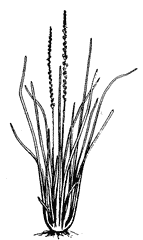 Arrow Grass (Triglochin maritima) |
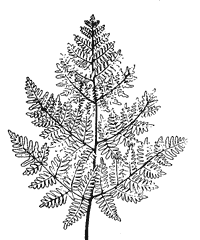 Bracken Fern (Pteridium aquilinum) |
 Goldenrod (Solidago Missouriensis) |
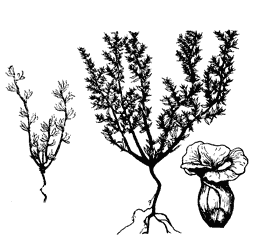 Halogeton (Halogeton glomeratus) |
 Locoweed (Oxytropis lambertii) |
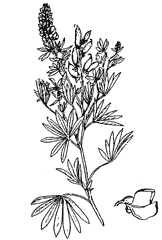 Lupine (Lupinus argenteus) |
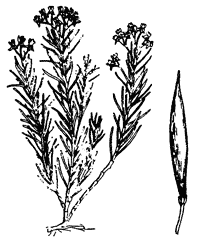 Milkweed (Asclepias pumila) |
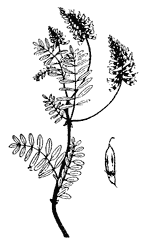 Milk Vetch (Astragalus bisulcatus) |
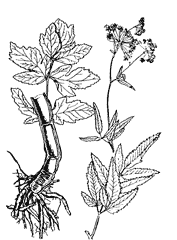 Water Hemlock (Cicuta maculata) |